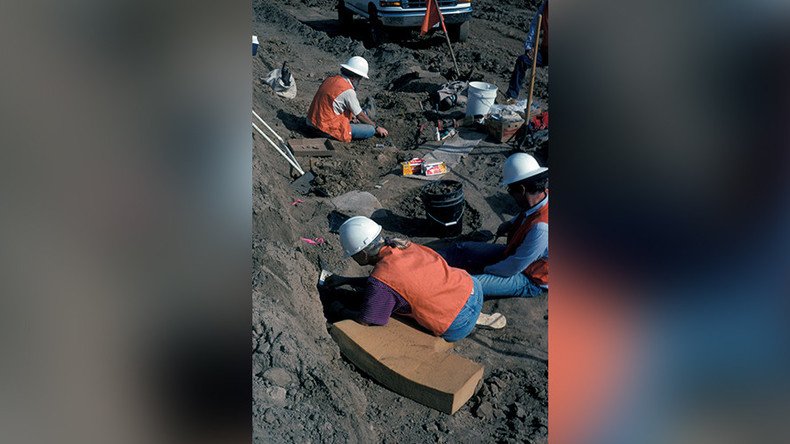‘Extraordinary evidence’ shows humans in North America 100,000 years earlier than first thought

Ancient mastodon remains found during the construction of a California freeway may prove that humans settled in North America more than 100,000 years earlier than first thought, according to a new study.
Researchers have been studying rock and bone fragments initially unearthed by heavy machinery at a San Diego construction site in 1992.
A study suggests that an unidentified hominin species may have been present in North America 130,000 years ago https://t.co/kjbNDcwZ8Apic.twitter.com/fVe1DxII6N
— nature (@nature) April 26, 2017
Now the team, led by archaeologist Steven Holen and paleontologist Thomas Deméré, believes it’s “strong” proof of human existence in the New World much earlier than the generally-accepted migration period 15,000 years ago.
Known as the Cerutti Mastodon site, fossils of a large elephantine animal and stones were found preserved in around (1ft) 30cm of sand and silt in the early 1990s.
READ MORE: Ancient ‘observatory’ may hold secret to ‘comet collision’ & sudden climate change
The partial skeleton of the mastodon included two tusks, three molars, four vertebrae, 16 ribs and more than 300 bone fragments.
The existence of the beast in modern day California is not jaw dropping in itself.
However, it’s the age of the mastodon remains and the fact that its skeleton may have been tampered with by an “unidentified species of homo” wielding stone tools around 130,000 years ago that’s causing a stir.
#CeruttiMastodon Press Conference comes to a close. To learn more about this exciting #Discovery, check out https://t.co/YbtJsaQrVi@AAMers
— theNAT (@SDNHM) April 26, 2017
A new study and letter detailing research methods at the Cerruti Mastodon site, which dates back to early late Pleistocene epoch, has been published in the journal Nature.
It’s provoked controversy, disbelief and awe by those within the science community, some of whom have asked that more evidence be provided and questions answered.
The authors of the mastodon study describe how, after the discovery, the bones and pieces of stone’s position were mapped while uranium-series dating was carried out after radiocarbon failed. The results reportedly gave an age estimate of more than 130,000 years.
Deméré, of the San Diego Natural History Museum, described the discovery as “startling.”
“It’s the 130,000-year age of the site that is really the most extraordinary result of our research,” Deméré told a press conference.
“I realize that 130,000 years is a big number when thinking about the early people of the Americas, especially when you consider that currently the oldest widely accepted date for humans in North America is 14-15,000 years ago.
“But of course as a scientist I realize that extraordinary claims such as this require extraordinary evidence and we feel that the Cerutti Mastodon site preserves such evidence,” he added.
Evidence of human existence cited in the study include “anvil” rocks that appear to have been used as crude work tools, as well as the juxtaposed state of the bones found at the location.
READ MORE: Hungry for humans: Ancient Spanish civilization feasted on people, study says
For example, the team observed how relatively fragile bones, the rib cage and vertebrae of the animal, remained intact while traditionally hardier leg bones were “dramatically” broken.
Impact marks and “use wear” displayed on rocks at the site also pointed to human activity in the area, the study claims.
Dr. Steve Holen - "Necessary to review other sites in #southerncalifornia to look for more evidence of #EarlyHumans" #CeruttiMastodon
— theNAT (@SDNHM) April 26, 2017
“These stones had to be brought [to the site] by humans because these large stones don’t occur naturally in this kind of sediment,” Steven Holen said.
“We also know from the fracture patterns on the bone. We see big impact notches from a rock hitting the bone and we have done experiments breaking elephant bone with large rocks to reproduce these kind of fracture patterns.”
Holen said he had been involved in studies on the Great Plains, Kansas, where similar human interaction with mammoth bones were discovered albeit dating back 30-40,000 years ago.
“Once I realized in my mind how old the [Cerutti Mastodon] site was I could not believe that humans were here at that time. It went against everything I had ever been taught and everything I thought I knew. So it was quite shocking, the shock of my scientific career but I knew we had to go ahead and publish this work,” he said.
It’s thought the bones could have been ‘processed’ for marrow for food and to make implements. Although, without further evidence some people remain unconvinced.












